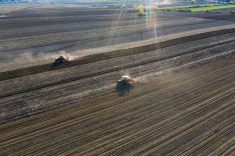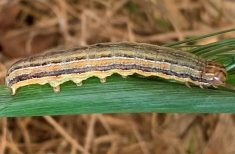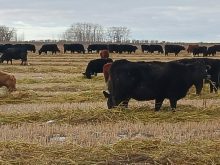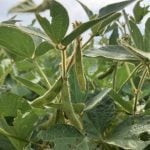What if your least productive acres could start turning a profit — without ever planting another cash crop?
Across the Prairies, some of the toughest farmland is getting a second look, not for what it can grow, but for what it can support. Instead of battling poor soil and disappointing yields, farmers are being offered real money to turn marginal acres into something more sustainable. Groups such as Ducks Unlimited Canada (DUC) and the Prairie Precision Sustainability Network (PPSN) are stepping up with incentives that make perennial forage a viable, profitable, alternative.
Seeding marginal cropland into perennial forage helps conserve soil health, reduce erosion, and improve water retention. It also provides habitat for wildlife, particularly waterfowl, and helps improve biodiversity. Additionally, it enhances carbon sequestration by stabilizing soil with deep-rooted plants, supporting long-term environmental sustainability. It’s easy to see the appeal for conservation groups.
Read Also

Claas brings 1000 Series SP forage harvesters to Canada
In mid-August, Claas unveiled its new line of Jaguar forage harvesters at an event in Visalia, California, deep in the heart of that state’s dairy region.
These incentive programs for marginal acres are relatively new. DUC began offering compensation to farmers for seeding unproductive cropland to perennial forage in 2019. PPSN began offering farmers support to convert marginal acres to perennial forage in 2024.
But while the incentives are recent developments, the problem of what to do with less productive areas of a farm are as old as agriculture itself. Darren Bond, a farm management specialist with Manitoba Agriculture, says farmers can make better decisions by considering the specific restrictions posed by different field conditions — such as susceptibility to drought, excess moisture, or soil compaction — that impact crop yield.
“Better land has fewer restrictions, and more marginal land has more restrictions,” Bond says. “Those restrictions would be things like being more susceptible to excessive moisture, excessive dryness or excessive stoniness, things that limit yield potential.”
Unfortunately, there is no exact science to determine those marginal acres. Sometimes factors such as favourable weather conditions and low disease or insect pressure may temporarily mask a problem. A farmer might get an excellent crop two or three years in a row after a run of good growing conditions and may assume that trend will carry on. But over the long term, that same parcel of land could drop below the profitability line more often than not.
“With land that’s a little bit more marginal, the yield swings can be a little bit higher,” Bond says. “So it does make it a little bit more difficult to make that decision.”
Another factor impacting the decision-making on marginal land is the cost of production. For the past year or two, farmers have been feeling the pinch of tight margins. Input costs have come down a bit over the last several months, but crop prices are remaining stubbornly low. Bond says farmers should expect that climate to continue.
“With tighter margins, the land that doesn’t produce as much is going to feel that squeeze sooner, a lot sooner than your average land,” he adds.
READ MORE: Bless your mess: Crops may not be best for underproducing acres
Bond also points out that when calculating costs of production, it’s important to factor in the time the farmer puts into managing that parcel of land.
“Maybe producers’ time would be better spent seeding that down to perennial forage and managing their other acres more intensely,” he says.
It’s complicated, but the tools are there to track yield and understand costs of production. Bond points out that having a clear view of what that land can produce will create a foundation for looking at what else could be done with the land. If a parcel of land is consistently underperforming, regardless of incentive, switching to perennial forage could be the right decision. It’s just a matter of roughing out the yield potential and profitability of that scenario and comparing it against staying the course.
“At least put numbers to the decision and try to take out some of the variables,” Bond says. “It could be the incentive is what pushes the decision over the edge.”

Ducks Unlimited Canada Marginal Lands Program
That’s certainly what the folks at Ducks Unlimited are hoping for. And the incentives they’re paying are significant. Their per-acre payment differs from province to province. In Manitoba, they’re offering $200 per acre; in Saskatchewan, it’s $135 per acre; and in Alberta, the incentive is $150 per acre.
Daphne Appleyard, DUC’s marginal areas specialist for Manitoba, says the conservation organization is focusing its efforts on the Prairie Pothole Region, which, in Canada, stretches across southwestern Manitoba, southern Saskatchewan and into Alberta.
“The region contains important natural habitat, including wetlands and upland, which improve soil health, water quality and biodiversity,” Appleyard says. “Conserving natural areas has also been shown to increase crop yields due to increased pollination and provide resilience during extreme weather events.”
In a press release pitching the benefits of the Manitoba marginal areas program, DUC says most farmers in southwestern Manitoba have to contend with marginal acres.
“The numbers are higher than you might expect,” says Sam Robinson, a research scientist who studies sustainable agriculture for DUC. “Common causes of marginal acres are too much or too little water, extra salinity and soil compaction.
Using data from Manitoba Agriculture’s 2025 Cost of Production Guide, DUC estimates the cost of growing red hard spring wheat at $350 per acre. At $8 per bushel and a yield of 65 bushels per acre, the profit is roughly $170 per acre. But in areas with mild salinity, where yields drop to just 45 bushels per acre, profit is reduced to only $10 per acre after input costs. In extreme cases, the cost of production exceeds any potential profit
“A farmer seeding wheat or canola into extreme saline areas could lose up to $418 per acre,” Appleyard says. “Fortunately, seeding those marginal areas to forages is a proven way to fix saline and weed issues. Plus, the forages can be used for livestock feed or sold, which increases the profitability of that land.”
Robinson notes weed infestations can also turn productive farmland into marginal farmland.
“We’re seeing herbicide resistance in kochia across the Prairies,” he says. “Some farmers will even do a chemical fallow, tilling the soil and applying herbicides with strong residual effects. This costs more time and money. The better solution is to have permanent cover in place that will compete with the weeds.”
The Prairie Precision Sustainability Network
PPSN’s incentive program is the second stage in a two-phase study that looks at marginal agricultural areas across the Canadian Prairies. In phase one, farmers provided their precision yield data, which helped create a detailed map of marginal acres and identify areas where conversion to perennial forage could be most beneficial.
The first phase is continuing, and the second phase, which launched in 2024, is going back to those farmers and asking them to convert those less-than-productive acres into perennial forage.
The PPSN began as a collaboration between research teams at the University of Saskatchewan in 2022, but since then the Universities of Manitoba and Waterloo have joined the effort.
Heading up the PPSN research team is Paul Galpern, associate professor of ecology and evolutionary biology at the University of Calgary. He says convincing farms to sign on to the second phase isn’t a difficult pitch — particularly since they’ve all participated in the first phase. They already have data showing the land in question is losing the farmer money. It’s really just a matter of pointing that out and suggesting they take a break.

“Let’s see if we can plant that in perennial forages. Firstly, you’re going to stop losing money, but secondly, you’re going to have an opportunity for soil rehabilitation and carbon sequestration,” Galpern says. “Those long roots of those plants are going to store carbon under the soil. They’re also creating habitats that could be great for beneficial insects in their surrounding field. It’s a win-win.”
Farmers who sign on to phase two of the PPSN program stand to benefit from a variety of incentives designed to support their transition to perennial forage. First, participants will receive a one-time signing bonus for their involvement in the preliminary year of testing.
Once the conversion is complete, they’ll be eligible for a land use payment of $75 per acre each year for the first two years, with the potential for additional payments depending on available funding. PPSN will also fund the forage seed and provide advice on best management practices to ensure the success of their new perennial crops.
‘Stackable’ benefits
The good news for farmers is that the PPSN incentive program is ‘stackable,’ meaning that farmers can combine it with other programs such as the DUC program to maximize their incentives and financial support.
Galpern points out that PPSN has been partnering with DUC since phase one of its project — and says he will tell participating farmers to give DUC a call.
“We’re making a change here that is completely aligned with Ducks Unlimited’s marginal areas program,” he says. “And if you go over to them, they’ll provide additional support to help you make this transition.”
There are other programs that farmers can stack as well. For example, PPSN is working with a company called Carbon Asset Solutions. Under certain situations, they will also pay farmers for converting to perennial forage, but with more of an eye to carbon sequestration.
“They’ll measure how much carbon you’re storing in the soil in the section of your field that you’ve changed, and they’ll use carbon offset markets to pay you for that carbon,” Galpern says. “It’s a really exciting new opportunity.”
Farmers participating in PPSN’s Phase 2 will receive information about all the compatible programs that offer incentives. According to Bond, programs like these could really simplify the decision-making for farmers.
“Including an incentive can reduce some of the uncertainty,” he says. “Any payments just make it a little bit clearer as to what you can see for returns.”
















